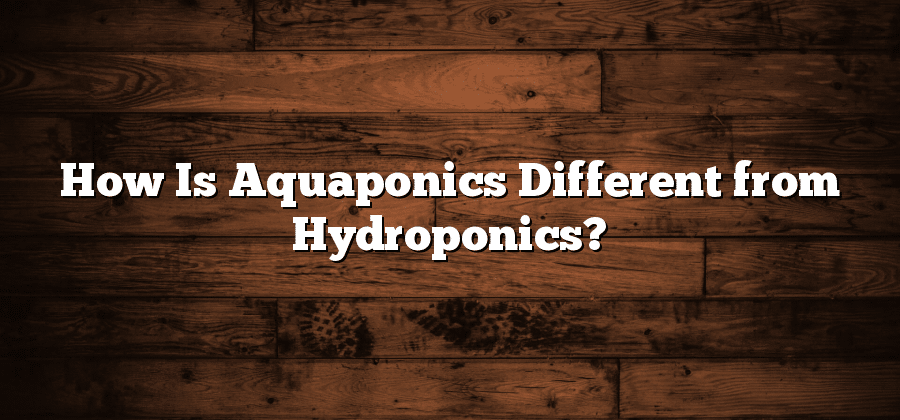Aquaponics and Hydroponics: Key Distinctions
Aquaponics and hydroponics, while both innovative methods of food production, have key distinctions that set them apart from each other. In aquaponics, the growth of plants is achieved through a symbiotic relationship between fish and plants. The fish provide essential nutrients and fertilizers for the plants, while the plants filter and purify the water for the fish. This integration of aquaculture and hydroponics creates a closed-loop system that maximizes resource utilization and minimizes waste.
On the other hand, hydroponics is a soilless cultivation technique that relies on nutrient-rich water to nourish the plants. In this method, plants are grown in a controlled environment, with their roots immersed in a solution containing all the necessary nutrients. The absence of soil eliminates the need for extensive space and allows for precise control over the growing conditions. Furthermore, with hydroponics, there is no reliance on fish or any form of aquaculture, making it a viable option even in areas where fish farming may not be feasible.
Aquaponics vs. Hydroponics: A Comparative Analysis
Aquaponics and hydroponics are both advanced systems of agriculture that provide unique benefits and challenges. Aquaponics combines hydroponics with aquaculture, creating a symbiotic relationship between plants and fish. In this system, **nutrient-rich** water from the fish tank is transferred to the plants, providing them with essential nutrients. The plants, in turn, act as a natural filter, purifying the water before it is circulated back to the fish tank. On the other hand, hydroponics is a method of cultivating plants in a soilless environment, where the roots are submerged in a nutrient solution. These systems are often used in controlled environments such as greenhouses to optimize plant growth and maximize resource efficiency.
One significant distinction between aquaponics and hydroponics is the presence of fish in aquaponics and their absence in hydroponics. The inclusion of fish in aquaponics not only provides a protein source but also helps maintain the nutrient balance in the system. The waste generated by the fish serves as a natural fertilizer for the plants, eliminating the need for additional **synthetic fertilizers**. In contrast, hydroponics relies solely on nutrient solutions to provide essential elements to the plants. This distinction highlights the potential environmental impact and resource efficiency of aquaponics, as it utili-…
Understanding the Core Principles of Aquaponics and Hydroponics
Aquaponics and hydroponics are two distinct systems used in modern agriculture. Aquaponics is a sustainable method that combines aquaculture and hydroponics to create a symbiotic relationship between fish and plants. In this system, the fish waste provides nutrients for the plants, while the plants help to filter and purify the water for the fish. This closed-loop system maximizes efficiency and minimizes waste, making it an environmentally friendly approach.
On the other hand, hydroponics is a soil-less method of growing plants that uses a nutrient-rich water solution as a substitute for soil. The plants are typically grown in containers or channels, with the water solution replenished regularly to ensure proper nutrient levels. This method allows for precise control over the plants’ environment, including factors such as pH, nutrient concentration, and water availability. By eliminating the need for soil, hydroponics offers several advantages, including higher crop yields, faster growth rates, and reduced water usage.
While both aquaponics and hydroponics rely on water as a medium for plant growth, the key distinction lies in the inclusion of fish in aquaponics. The fish play a crucial role in providing nutrients for the plants, creating a closed-loop system that is highly sustainable. In hydroponics, however, the absence of fish means that the nutrients must be supplied solely through the water solution. Despite their differences, both aquaponics and hydroponics are viable alternatives to conventional farming methods, offering more efficient, controlled, and sustainable approaches to food production.
The Role of Fish in Aquaponics and its Absence in Hydroponics
Aquaponics and hydroponics are two distinct methods of cultivating plants, each with its own unique characteristics and benefits. One key distinction between the two lies in the role of fish. In aquaponics, fish play a crucial role in the system as they provide the necessary nutrients for plant growth. The fish waste, rich in ammonia, is broken down by beneficial bacteria into nitrites and nitrates, which are essential nutrients for plants. These nutrients are then absorbed by the plants, ensuring their healthy growth. The presence of fish in aquaponics creates a symbiotic relationship where the fish benefit from a clean and filtered water environment, while the plants benefit from the nutrients provided by the fish waste.
On the other hand, hydroponics does not involve the use of fish or any living organisms in its cultivation process. Instead, plants are grown in a nutrient-rich water solution that can be supplemented with synthetic nutrients. In hydroponics, nutrient solutions are precisely calibrated to meet the specific needs of the plants, providing them with optimal conditions for growth. By eliminating the use of fish, hydroponics focuses solely on delivering the essential nutrients directly to the plants. This allows for greater control over the nutrient levels and pH balance, resulting in efficient nutrient uptake and potentially faster-growing plants. However, without the presence of fish, the hydroponic system lacks the natural, symbiotic relationship found in aquaponics.






